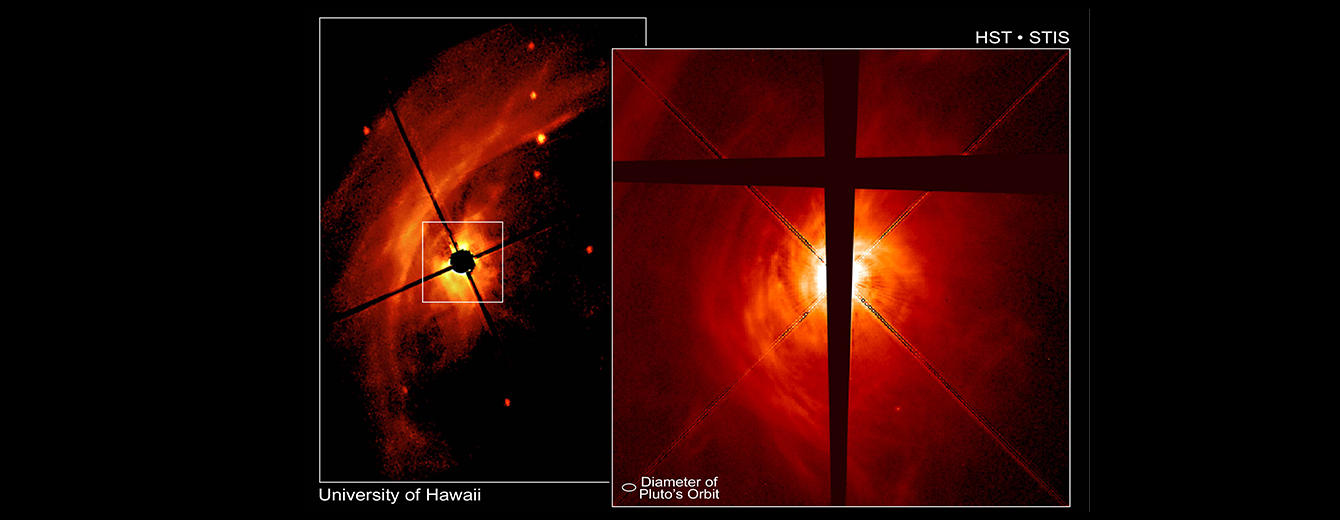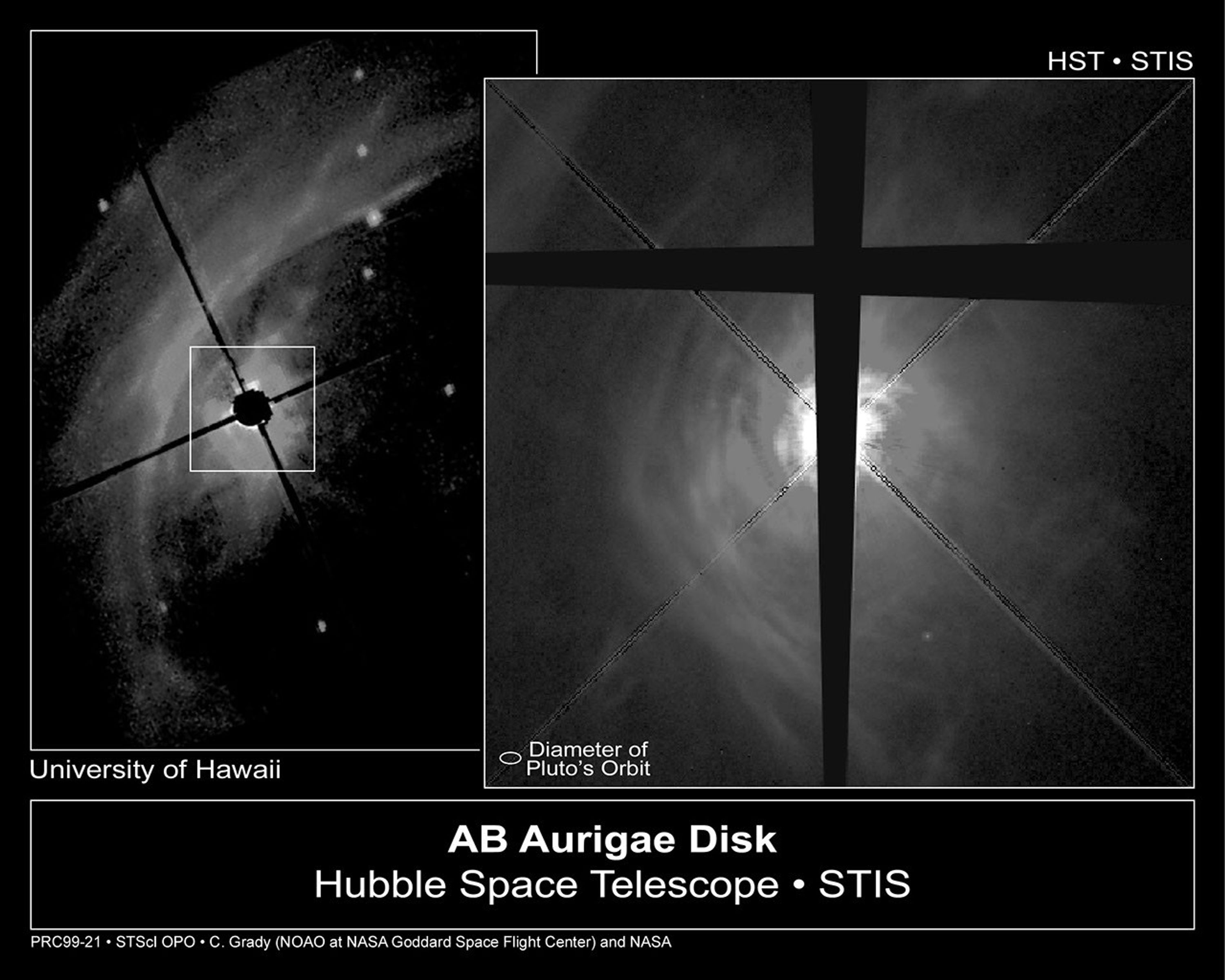
How do you cook up a planetary system? Astronomers can rattle off the primary ingredients: gas, dust, and ice. They have seen the prepared dish: our solar system. Now a detailed image of a developing star taken by NASA's Hubble Space Telescope is helping them write the recipe.
A visible-light image, taken with Hubble's Space Telescope Imaging Spectrograph, reveals clumps of material in a circumstellar disk of gas and dust swirling around a 2- to 4-million-year-old star called AB Aurigae. These clumps, also composed of dust and gas, may represent the seeds of planet formation. Studying developing stars in the 1- to 10-million-year-old age range, such as AB Aurigae, could provide an evolutionary missing link in the planet formation process.
"These observations suggest that the transition from gas and dust disks to debris disks with planets occurs around stars that are 1 to 10 million years old," explains Carol Grady of the National Optical Astronomy Observatories, working at the NASA Goddard Space Flight Center in Greenbelt, Md. "We have seen the beginning and the end of the planet formation process. Recent Hubble telescope observations have shown protoplanetary disks encircling young stars up to 1 million years old and planetary disks surrounding more mature stars around 8 to 20 million years old. Now we want to see what is happening in the middle."
Grady will discuss her findings at a press conference at 12:30 p.m. CDT (1:30 p.m. EDT) June 2 at the summer meeting of the American Astronomical Society in Chicago, Ill.
Although the astronomer and her team haven't spied any planets in the disk, the features they have seen intrigue them.
"We don't see any evidence of unseen large bodies sweeping out dust lanes," Grady says. "But we have seen unprecedented structure in the dust clouds, suggesting that material is beginning to clump together in a process which could form planets in the next few million years."
The smallest clumps visible in this false-color image are near the limits of the telescope's resolution. All the clumps are extremely large: 1.3 to 3 billion miles (2 to 5 billion kilometers) wide or 14 to 32 times Earth's distance from the Sun. They also reside much farther away from AB Aurigae than Pluto, our outermost planet, does from the Sun. The largest clump, for example, is about 32 billion miles (51 billion kilometers) away. This distance is equivalent to 88 times Pluto's distance from the Sun.
"Similar features haven't been seen in the disks surrounding younger, 300,000-year-old to 1-million-year-old, stars," Grady says. "In those younger stars, we don't see as much structure as in AB Aurigae. Star systems a bit older than AB Aurigae have cleared lanes or zones suggesting that large planets have developed. The AB Aurigae image, together with the other Hubble telescope studies, suggests that the transition from a protoplanetary disk to a system with planets occurs sometime after 2 to 4 million years, but before 8 million years."
AB Aurigae, about 2.4 times more massive than the Sun, resides 469 light-years from Earth in the constellation Auriga. Its circumstellar disk is extremely wide, at least 121 billion miles (194 billion kilometers). Thirty of our solar systems would fit inside it. The disk is slightly larger than the nearby and better-studied Beta Pictoris system.
Normally, probing the material in a circumstellar disk is difficult because the glare of the central star overpowers the feeble reflected light from the dusty disk. To overcome this powerful light, Grady and her team used the imaging spectrograph's coronograph, which blocks the light from the star to create an artificial eclipse.
Grady admits she needs more information on developing stars in order to draw any conclusions on planet formation. That's why she and the Space Telescope Imaging Spectrograph team have mapped out a two-year survey to study young, bright, nearby stars in the 1- to 10-million-year age range.
"Astronomers are searching for answers to planet formation," Grady explains. "For example, is planet formation common? "How, when, and where do planets form? And what role does a star's environment and size play in planet formation?"
AB Aurigae has been a popular target. The team selected this star because of previous observations by ground- and other space-based telescopes. Ground-based observations in millimeter wavelengths had shown that the star has a large gas and dust disk; space- and ground-based infrared studies had suggested that the disk material extends in very close to the star, much farther than the imaging spectrograph can see.
The team plans further observations of AB Aurigae to search for comets. Finding comets would mean that some of the clumps of dust and gas have coalesced to form solid bodies at least a half-mile (1-kilometer) wide. The astronomers will use the imaging spectrograph and NASA's soon-to-be launched Far Ultraviolet Spectrograph Explorer to hunt for them.
This research was supported by a NASA grant to the National Optical Astronomy Observatories (NOAO). NOAO is operated by the Association of Universities for Research in Astronomy (AURA), Inc., under cooperative agreement with the National Science Foundation.
The Space Telescope Science Institute is operated by AURA under contract with NASA's Goddard Space Flight Center in Greenbelt, MD. The Hubble Space Telescope is a project of international cooperation between NASA and the European Space Agency (ESA).

































